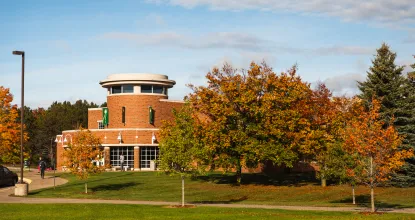The EEGS department is rooted in Geography. Geography was one of the original subjects taught when the State Board of Education created Northern State Normal School on July 14, 1899. Martha B. Ackermann taught the first geography courses. The program included physical geography, meteorology, and a general course for teachers of geography. Drawing courses that included cartography were also offered. In 1903, general geography (human geography) replaced the course for teachers and commercial geography supplanted physical geography and meteorology.
The Geography Department was officially created in 1905, with Frances Martin Kelsey as its head. One early departmental change included an increase in the availability of text materials. Such materials reduced the department’s emphasis on the maps, models, laboratories, and field trips that were used to teach geography early in the century. New offerings included courses in geology and continental geography.
Most graduates of the department in the first half of the 20th century became teachers, but jobs for geographers in government and industry increased in the second half of the century.
The department’s course offerings in conservation in the 1960s attracted some of the transient, environmentally attuned members of the nation’s burgeoning counterculture known as “the backpackers.” They would attend Northern for one or two semesters and then move to another college town. At one point in the mid-1960s, more than 600 NMU students were majoring in the Geography Department.
By the early 1970s, the Geography Department had 11 full-time and two part-time professors. Courses were often revised to meet the specific needs of employers. Diverse course offerings included recreation planning, biophysical systems, and environmental studies.
As the department grew and expanded, its name did as well. In 1960, the Department of Conservation and Agriculture became a part of the Geography Department. In March 1963, agriculture was discontinued as a part of geography. The name of the Geography Department was changed to the Department of Geography, Earth Sciences, Conservation, and Planning, effective July 1, 1986. In 1998 the name reverted to the Geography Department.
By the mid-1990s, the department offered programs in applied geography, teacher education, and preparatory work for graduate study. The department also taught quality courses that satisfied NMU’s liberal studies requirements in the areas of social science, natural science/mathematics, and world cultures. Undergraduate majors offered by the department were land-use planning and management, environmental conservation, physical geography, human geography, and earth science. These majors prepared students for a variety of careers and professions, ranging from government service to private industry to research.
In 2011, the renamed Earth, Environmental, and Geographical Sciences Department launched a revised curriculum. The four programs currently offered are Environmental Studies & Sustainability, Environmental Science, Earth Science, and GIS & Technology. True to the roots of the institution, students can still prepare for a career in teaching. The secondary education programs related to EEGS prepare students to social studies or integrated sciences. About 240 students are majoring in programs offered by the EEGS Department.
The department’s laboratory for computer mapping is state-of-the-art. Students use Global Position Systems (GPS) for classes and projects to locate and map campus buildings, roadways, and physical features of the environment. Students can learn to integrate spatial data from multiple sources using Geographic Information Systems (GIS) to create maps that help answer a wide range of questions with applications for management, conservation, planning, historical and archaeological reconstruction, and business.
Department chairs and heads:
- Frances Martin Kelsey, 1905-1906;
- Charles H. Estrich, 1906-1909;
- Ward Magoon Mills, 1909-1910;
- Theodosia Hamilton Hadley, 1910-1911;
- DeForest Stull, 1909-1923;
- J. Russel Whitaker, 1924-1930;
- Lynn Halverson, 1930-1962;
- Henry Heimonen, 1962-1972;
- John Hughes, 1972-1978;
- Jarl Roine, 1978-1988;
- Alfred Joyal, 1989-1992;
- J. Pat Farrell, 1992-1997;
- Alfred Joyal (acting), 1997;
- Michael Broadway, 1997-2008;
- John B. Anderton, 2008-11;
- Susy Svatek Ziegler, 2011-25;
- Sarah Mittlefehldt, 2025-26.
Source: A Sense of Time: The Encyclopedia of Northern Michigan University.
